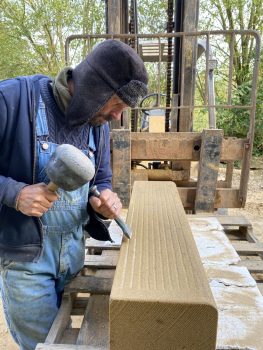November 3-5
(Click on any of the below photos to open a higher resolution version.)
Shropshire has supposedly had the wettest October for 120 years. But unlike Canute, we just about succeeded in holding back the water during this month’s work party.
The channel in Phase 1A typically starts filling with water in December or January. Not so this year. But thanks to pumping during the week before and throughout the work party, first with one, then two and eventually three pumps, we managed to keep this area dry enough for activities to continue. ‘Dry’ would be a misnomer – though more of that later. This report starts with the results of the water testing carried out last month.
Testing continued for 6 days. As has previously been reported, the testing in Phase 1B established that some form of waterproofing will be required. After 24 hours of pumping, the water level rose a meagre 19cm, whereas it was estimated that it should take 16-17 hours to completely fill the channel if it was watertight. Leakage was identified at the base of the embankment and the test was terminated. The Phase 1A test area did hold water. Repairs to the channel bank in August appear to have been successful and there was no leakage past the embankment. The test area was filled three times. The water level dropped over time at approximately the same rate on each occasion, passing beneath the northern dam into the channel towards Crickheath Bridge. The results will be reviewed with CRT and the design and specification finalised with the aim of commencing channel restoration works early in the new year.
The first job this month was to fully decommission the water tests. This involved removal of three clay dams starting with the two in Phase 1A, thereby re-establishing plant access to the wharf wall area. Removal of the third dam in the Phase 1B test area was completed on Saturday and the area made good. The clay has been stored on site for future use.

Having regained plant access to the wharf wall area on Friday afternoon, the opportunity was taken to clear the site of surplus stone and other materials in readiness for placing coping stones onto the newly-repaired wall. Whilst the ground by the wall itself remained firm, the channel bed turned to deep mud due to the repeated plant movement exacerbated by steady rainfall on Saturday. Thankfully none of the plant got stuck.

Many of the existing coping stones can be reused but a good number have degraded, delaminated and generally disintegrated over the centuries. Replacement natural stone, hand-tooled copings have been sourced, funded by a generous grant from the Association for Industrial Archaeology. There are two areas where these will be used. Placing these on top of a dry-stone wall with an uneven surface is a fiddly job but over Saturday and Sunday, one stretch was completed, a length of 12.2 metres. A total of 20 metres of copings have now been placed on the repaired wall. A further 70 metres remains – this will now wait till next year when water levels in this part of the channel once again become manageable.
One of several activities planned for the winter is hedge laying in an area of Phase 2. In preparation for this, a quantity of dead wood (saplings and small trees) was removed from the hedge to the bonfire area and piled around the stump ready for future burning. After a few quiet months, a further ‘stump saga update’ beckons.




